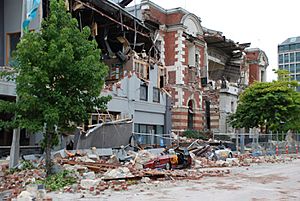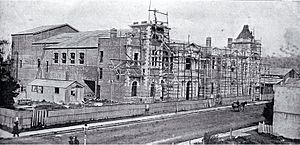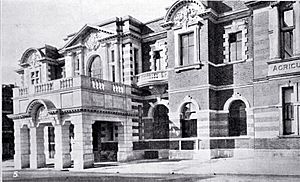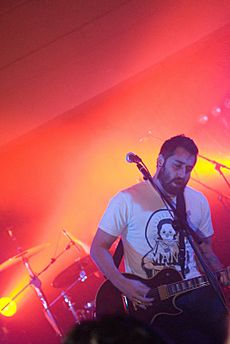Civic, Christchurch facts for kids
Quick facts for kids Civic |
|
|---|---|

The Civic in 2009
|
|
| General information | |
| Type | Former civic offices |
| Location | Christchurch Central City |
| Address | 194–198 Manchester Street |
| Town or city | Christchurch |
| Country | New Zealand |
| Coordinates | 43°31′49″S 172°38′24″E / 43.5303°S 172.6399°E |
| Construction started | 14 March 1900 |
| Inaugurated | 1 November 1900 |
| Renovated | 1922–1924 |
| Demolished | 2011 |
| Client | Christchurch City Council |
| Technical details | |
| Floor count | two |
| Design and construction | |
| Architecture firm | Clarkson & Ballantyne |
| Main contractor | Rennie and Pearce |
| Renovating team | |
| Architect | Greenstreet and Anderson |
| Renovating firm | W. Williamson |
| Designated: | 26-Nov-1981 |
| Reference #: | 1870 |
The Civic was a famous building in Christchurch Central City, New Zealand. It stood on Manchester Street for over 100 years. This building had many different lives.
It started as a grand exhibition hall in 1900. Later, it became a cinema and then a theatre. Sadly, a big fire destroyed much of it in 1917.
After the fire, the Christchurch City Council bought part of the building. They turned it into their main office in 1924. The council used it until 1980.
In its later years, the Civic became a popular spot for fun. It was a restaurant, a bar, and a place for live music. Many famous bands played there.
The building was badly damaged in the February 2011 Christchurch earthquake. Because of the damage, it had to be taken down. The Civic was also a special heritage building. This meant it was important to New Zealand's history.
Contents
The Civic's Amazing Journey Through Time
The Grand Opening: A Hall for Exhibitions
The Civic building was first known as the Agricultural and Industrial Hall. Some people also called it the Canterbury Hall. It was built in 1900 on Manchester Street.
The Mayor, William Reece, laid the first stone on March 14, 1900. Architects Clarkson & Ballantyne designed the building. They created it for Christchurch's 50th birthday celebration. This celebrated the arrival of the First Four Ships in 1850. Rennie and Pearce were the builders.
The Canterbury Industrial Association helped make the building happen. They teamed up with the Agricultural and Pastoral Association. Together, they formed a company to own the hall. Samuel Brown, a leader of the Industrial Association, called it "possibly the finest hall in New Zealand."
The building officially opened on November 1, 1900. The Mayor's wife, Mrs. Reece, did the honours. Later that day, the Governor, The Earl of Ranfurly, opened a special exhibition. Important leaders like Richard Seddon and Joseph Ward were there. The whole city had a public holiday that afternoon!
The exhibition was huge, covering about 7,400 square metres. It took up two-thirds of a city block. Almost 250,000 people visited it. The exhibition made a profit of £3,000.
From Theatre to Fire: His Majesty's Theatre
After the exhibition, the Canterbury Hall became a cinema. It could seat 3,000 people. In 1906, it was changed into a theatre. The seating was reduced to 1,400, and its name became His Majesty's Theatre.
The new theatre opened on August 28, 1906. The first show was a funny opera called Erminie. A company called Fuller's leased the theatre in 1917. But on November 11, 1917, a terrible fire broke out.
The building was completely destroyed, except for its front wall. It was valued at £21,000. The city's large organ, worth £5,000, was also lost in the flames. The building had just been offered to the Christchurch City Council to use as a town hall.
A New Purpose: Municipal Offices
In 1919, the Christchurch City Council needed new offices. Their old building was too small. So, in 1920, the Council bought the northern part of the burned-out Civic building. This was at 194 Manchester Street.
The southern part of the old building became the Civic Theatre in 1928. This theatre was taken down in 1983. This meant the impressive front of the 1900 building was cut in half.
Greenstreet and Anderson were the architects for the new council offices. W. Williamson was the builder. The Mayor's wife, Monica Thacker, laid a special foundation stone. The building opened on September 1, 1924.
The design was like an American bank. There was one long, curved desk in the main hall. This allowed people to easily reach all council departments. An impressive archway, called a portico, was built over the footpath. However, this was later removed.
For a while, all council staff were in one place. But by 1943, the council grew too big. Staff had to move into other buildings. By 1978, council staff were spread across nine different buildings!
A new Christchurch Town Hall was built in Kilmore Street. It opened in 1972. The council planned to build new offices nearby. But this plan didn't happen. Instead, the council bought Miller's Department Store in Tuam Street in 1978. They moved their offices there in 1980. The City Council then sold the Civic building in 1982 for $760,000.
Life After the Council: A Place for Fun
After 1982, the Civic had many different owners and uses. In 1984, it was the Civic Regency Restaurant. In 1986, it was renamed The Civic again. It became a popular bar and a live music venue.
Many famous New Zealand bands played there. These included Salmonella Dub, Shapeshifter, Elemeno P, and Anika Moa. It also hosted night shows for the yearly buskers festival. The Civic stopped hosting music events in 2009.
The End of an Era: The 2011 Earthquake

The Civic building was severely damaged in the February 2011 Christchurch earthquake. A large part of its front wall fell into Manchester Street. The building was so badly hurt that it had to be demolished in 2011.
After the earthquake, a special time capsule was found inside the building. Mayor Bob Parker opened it on April 12, 2011. The time capsule from the Civic held old newspapers, a photo book, and council financial reports from 1921.
Images for kids






